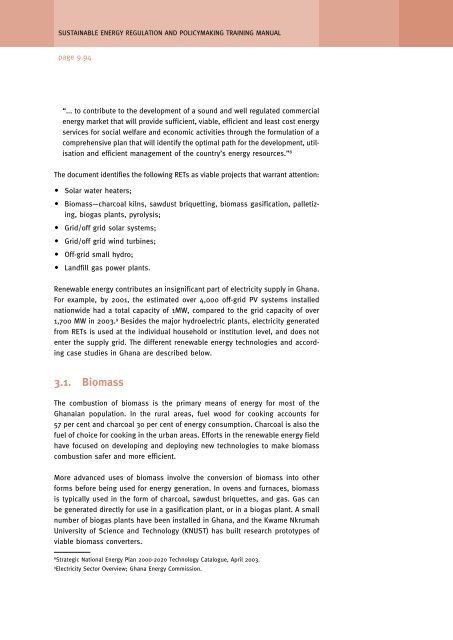Regulatory and policy options to encourage development of ...
Regulatory and policy options to encourage development of ...
Regulatory and policy options to encourage development of ...
- No tags were found...
You also want an ePaper? Increase the reach of your titles
YUMPU automatically turns print PDFs into web optimized ePapers that Google loves.
SUSTAINABLE ENERGY REGULATION AND POLICYMAKING TRAINING MANUALpage 9.94“... <strong>to</strong> contribute <strong>to</strong> the <strong>development</strong> <strong>of</strong> a sound <strong>and</strong> well regulated commercialenergy market that will provide sufficient, viable, efficient <strong>and</strong> least cost energyservices for social welfare <strong>and</strong> economic activities through the formulation <strong>of</strong> acomprehensive plan that will identify the optimal path for the <strong>development</strong>, utilisation<strong>and</strong> efficient management <strong>of</strong> the country’s energy resources.” 8The document identifies the following RETs as viable projects that warrant attention: Solar water heaters; Biomass—charcoal kilns, sawdust briquetting, biomass gasification, palletizing,biogas plants, pyrolysis; Grid/<strong>of</strong>f grid solar systems; Grid/<strong>of</strong>f grid wind turbines; Off-grid small hydro; L<strong>and</strong>fill gas power plants.Renewable energy contributes an insignificant part <strong>of</strong> electricity supply in Ghana.For example, by 2001, the estimated over 4,000 <strong>of</strong>f-grid PV systems installednationwide had a <strong>to</strong>tal capacity <strong>of</strong> 1MW, compared <strong>to</strong> the grid capacity <strong>of</strong> over1,700 MW in 2003. 9 Besides the major hydroelectric plants, electricity generatedfrom RETs is used at the individual household or institution level, <strong>and</strong> does notenter the supply grid. The different renewable energy technologies <strong>and</strong> accordingcase studies in Ghana are described below.3.1. BiomassThe combustion <strong>of</strong> biomass is the primary means <strong>of</strong> energy for most <strong>of</strong> theGhanaian population. In the rural areas, fuel wood for cooking accounts for57 per cent <strong>and</strong> charcoal 30 per cent <strong>of</strong> energy consumption. Charcoal is also thefuel <strong>of</strong> choice for cooking in the urban areas. Efforts in the renewable energy fieldhave focused on developing <strong>and</strong> deploying new technologies <strong>to</strong> make biomasscombustion safer <strong>and</strong> more efficient.More advanced uses <strong>of</strong> biomass involve the conversion <strong>of</strong> biomass in<strong>to</strong> otherforms before being used for energy generation. In ovens <strong>and</strong> furnaces, biomassis typically used in the form <strong>of</strong> charcoal, sawdust briquettes, <strong>and</strong> gas. Gas canbe generated directly for use in a gasification plant, or in a biogas plant. A smallnumber <strong>of</strong> biogas plants have been installed in Ghana, <strong>and</strong> the Kwame NkrumahUniversity <strong>of</strong> Science <strong>and</strong> Technology (KNUST) has built research pro<strong>to</strong>types <strong>of</strong>viable biomass converters.8Strategic National Energy Plan 2000-2020 Technology Catalogue, April 2003.9Electricity Sec<strong>to</strong>r Overview; Ghana Energy Commission.










